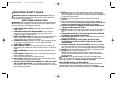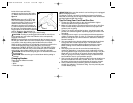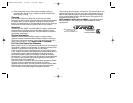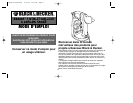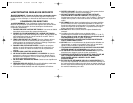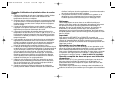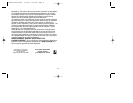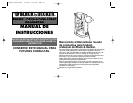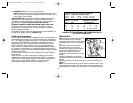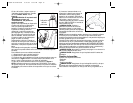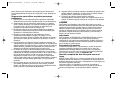
4
inside of the base and lift the
receptacle and cord out of the holder.
4.) Rotate stand forward as shown in
figure 4.
NOTE: Make sure unit is “OFF” and
cool before adjusting kickstand. We
recommend placing a piece of scrap
material under nozzle to prevent
damage to surface unit is resting on.
5.) Insert receptacle into the handle of
the glue gun (cord facing back of unit).
Plug cord into a 120 Volt AC outlet and
wait for “Ready for Use Indicator” to
turn from GRAY to RED or when glue starts flowing.
CAUTION: Feeding or pushing glue sticks with too much force
into a heated gun may cause hot adhesive to be unexpectedly
expelled from nozzle.
NOTE: Some materials can be damaged by the hot nozzle or even
the hot glue. Where this is a concern, test a piece of scrap material
or a portion of the object being repaired that will not be visible.
When all gluing operations are completed, place the gun back in the
cradle and unplug the cord to allow the gun to cool to room
temperature. DO NOT ATTEMPT TO PULL THE UNUSED STICK
FROM GUN AFTER USE. Any unused adhesive can be reheated
and used at a future date without any loss of bonding strength.
CAUTION: Do not confine the glue gun in an area where the heat
cannot dissipate.
CAUTION: Make sure the gun is cooled down before putting in
storage.
Changing Nozzles
There are three different nozzles:
• Standard
• Wide
• Extended Angle
CAUTION: Make sure the nozzle is cool and the gun is unplugged
before changing nozzles.
To change a nozzle, a wrench is included and stores in the base.
Note that a nozzle tip can be aligned independent of the nozzle base
and then tightened with the wrench.
Tips On Using Your Cord Free Glue Gun
1. Choose the right glue stick for the right application. High or
multi-temperature round glue sticks only.
2. Make sure the surfaces are clean and free from dirt or oily films.
Clean surfaces always bond best so take time to prepare the
surfaces prior to gluing.
3. There is no need to spread the hot glue. Just simply apply and
position the surfaces together squeezing slightly to ensure even
spreading.
4. It’s always best to work in a room with an ambient temperature
of 68 to 72 degrees F(20 °C et 22 °C). Extreme cold will quicken
adhesive set-up time (the time it takes the adhesive to harden).
Heat will extend it.
5. You can extend set-up time by slightly prewarming the surfaces
to be glued with a hand held hair dryer. The heat will allow
additional time to position difficult objects and also to ensure
better bonding of more difficult substrates (surfaces to be
bonded).
6. Glue drying time can also be controlled somewhat by the
method of application. Large heavy pools of adhesive will take
up to fifty percent longer to dry than normal size drops. Very thin
beads will dry in as few as 10 seconds. Some experimentation
with your glue gun on scrap material will help to determine the
best method to use for your particular project.
7. Use hot melt glue to hold projects together while you install more
permanent fasteners like nails, screws, bolts, etc. This makes
the whole project stronger and eliminates the need for clamps.
8. Some paints and stains containing petroleum distillates can
weaken the adhesive. Test before using. You may need to paint
or stain before gluing.
Stand
4
632900-00 GLUE GUN 6/15/05 8:19 AM Page 4




